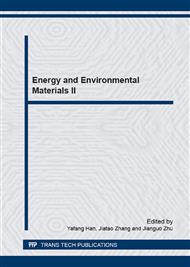[1]
China highroad website: http: /www. cngaosu. com/a/2014/0306/480566. html.
Google Scholar
[2]
N. Santero, A. Loijos, J. Ochsendorf, Greenhouse Gas Emissions Reduction Opportunities for Concrete Pavements. Journal of Industrial Ecology, Vol. 17 (6)(2013), pp.859-868.
DOI: 10.1111/jiec.12053
Google Scholar
[3]
T. Häkkinen, and K. Mäkelä, Environmental Impact of Concrete and Asphalt Pavements, in Environmental adaption of concrete. Technical Research Center of Finland. Research Notes 1752. (1996).
Google Scholar
[4]
A. Horvath, and C. Hendrickson, Comparison of Environmental Implications of Asphalt and Steel-Reinforced Concrete Pavements. Transportation Research Record. 1626(1998) 105-113.
DOI: 10.3141/1626-13
Google Scholar
[5]
H. Stripple, Life Cycle Inventory of Asphalt Pavements. IVL Swedish Environmental Research Institute Ltd(2000).
Google Scholar
[6]
Nicholas J Santero, Arpad Horvath, Global warming potential of pavements. Environ. IOP 1 Publishing. Environ. Res. Lett. Vol. 4, (2009).
DOI: 10.1088/1748-9326/4/3/034011
Google Scholar
[7]
H. Zhang, G.A. Keoleian, M.D. Lepech, An integrated life cycle assessment and life cycle analysis model for pavement overlay systems. Life-Cycle Civil Engineering – Biondini & Frangopol(2008).
DOI: 10.1201/9780203885307.ch141
Google Scholar
[8]
W. Philip, Jay S. Goldenb, Krishna P. Biligiri c, Kamil Kaloushd, Modeling climate change impacts of pavement production and construction. Journal of Resources, Conservation and Recycling. 54(2010) 776-782.
DOI: 10.1016/j.resconrec.2009.12.007
Google Scholar
[9]
M. Sofiia, Life Cycle Impacts of Road Infrastructure: Assessment of energy use and greenhouse gas emissions. Licentiate Thesis in infrastructure (2012).
Google Scholar
[10]
W. Roudebush, Environmental value engineering (EVE) environmental life cycle assessment of concrete and asphalt highway pavement systems. Portland Cement Association. PCA R&D Serial No. 2088. (1996).
Google Scholar
[11]
R. Berthiaume, and C. Bouchard, Exergy analysis of the environmental impact of paving material manufacture. Transactions of the Canadian Society for Mechanical Engineering. 23 (1999)187-196.
DOI: 10.1139/tcsme-1999-0013
Google Scholar
[12]
L.F. Zhao, D.F. Fu, C.X. Qian, T.H. Huang. Environmental impact evaluation method for making cement concrete road [J]. Journal of highway and transportation technology, 08(2004) 138-141.
Google Scholar
[13]
L. Zheng, Pavement material LCA and its informationization development. Changsha University of Science and Technology(2007).
Google Scholar
[14]
X.X. Zhou, Z.L. Song, Life cycle assessment of two kinds of concrete pavement. environmental engineering, (2009)472-475.
Google Scholar
[15]
S.Y. Xu, Y.H. Jia, Y. Gao, The consumption of natural resources research on highway. technology of highway and transport, 01(2006)120-122.
Google Scholar
[16]
C.J. Shang, Z.H. Zhang, X.D. Li, The life cycle energy consumption and emission of highway. highway traffic science and technology, 08(2010)149-154.
Google Scholar
[17]
Design specification of cement concrete road—JTG D40-2011. People's Republic of China Ministry of Transportation, Industry standards of People's Republic of China. (2011).
Google Scholar
[18]
Z.K. Yao. Manual of Design Roads-Road Surface. People's Transportation Press, Beijing, (2006).
Google Scholar
[19]
L.S. Li. The Application of Asphalt Slide Seal Coat in the Pavement of Cement Concrete. Road Transportation of Technology. 06(2006)57-58.
Google Scholar
[20]
M.N. Zhao. Life Cycle Assessment of Concrete Structural Components of Dwelling, Beijing University of Technology, (2013).
Google Scholar
[21]
B.R. Yuan, Z.R. Nie, X. h. Di, T.Y. Zuo, Life cycle inventory of Chinese fossil energy production II. Results single compilation. Modern chemical industry, 27 (4), (2006) 59-61.
Google Scholar
[22]
X. h. Di, Z.R. Nie, B.R. Yuan and T.Y. Zuo. Life Cycle Inventory for Electricity Generation in China. Int J LCA, Vol. 12 (4), (2007) 217–224.
DOI: 10.1065/lca2007.05.331
Google Scholar
[23]
A. Andrias, Z. Samaras, K.H. Zierock, The Estimation of the Emissions of other Mobile Sources and Machinery,: Subparts off-road Vehicles and Machines, Railways, and inland Waterways in the European Union: Final Report; EU Study Contract Number B4-3040/93/000803/B3. (EnviCon, 1994).
Google Scholar
[24]
S. Eggleston, D. Gaudioso, N. Gorißen, R. Joumard, R.C. Rijkeboer, Z. Samaras and K. -H. Zierock (1993).
Google Scholar
[25]
F. Giustozzi, M. Crispino, G. Flintsch, Multi-attribute life cycle assessment of preventive maintenance treatments on road pavements for achieving environmental sustainability[J]. The International Journal of Life Cycle Assessment, Vol. 17(4), (2012).
DOI: 10.1007/s11367-011-0375-6
Google Scholar
[26]
U.S. Environmental Protection Agency. Exhaust and crankcase emission factors for nonroad engine modeling-compressionignition, EPA-420-R-10-018. NW Washington, DC: United States Environmental Protection Agency, (2010).
DOI: 10.2172/569107
Google Scholar
[27]
X.B. Zhang. Construction methods of paving cement stabilized (bottom) base with thickness of 28cm . South-West Road, 01(2013)13-19.
Google Scholar
[28]
Zhenjiang Huachen Huatong 1220MAXI-PAV. Machine of Construction, 03 (2006).
Google Scholar
[29]
J. Meil, A life cycle perspective on concrete and asphalt roadways: embodied primary energy and global warming potential. Athena Research Institute, (2006).
Google Scholar


